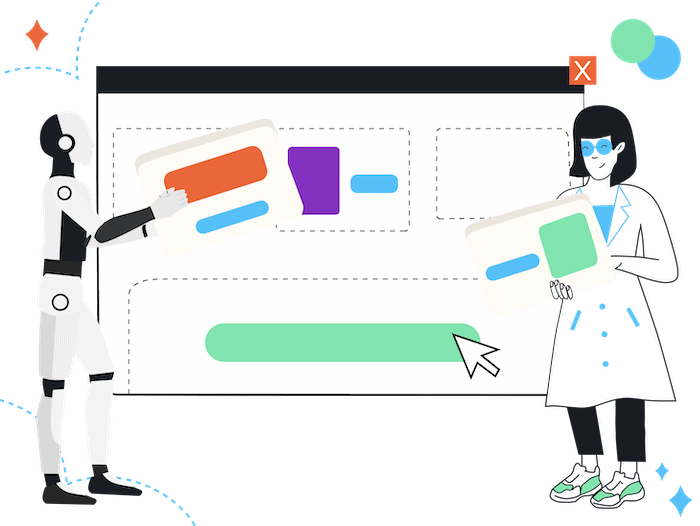As a Shopify store owner, I’m constantly on the lookout for tools that streamline my workflow. And Shopify’s new suite of artificial intelligence (AI) features promises to do just that. Shopify Magic can generate content in seconds. It can summarize endless pages of app reviews, and help with customer service. And even more features are set to roll out soon.
But how well do these AI tools work? Do they really save time, or is it just one more thing to learn?
I’ve been testing Shopify Magic in my own store and learning how to take advantage of AI to build my business. Here’s my hot take so far:
Shopify’s AI tools are useful and can boost your productivity. But they don’t spell the end of human creativity for ecommerce store owners. At least not yet. 😅
So, let’s take a look at what Shopify Magic can (and can’t) do for your ecommerce store. Along the way, we’ll explore alternatives such as ChatGPT and compare AI features available on other ecommerce platforms.
We’ll also look ahead to Shopify’s upcoming release: Sidekick. This AI tool could be a complete game-changer for Shopify store owners. That is, if it delivers on its promise!
What can Shopify Magic do?
Here’s what Shopify’s expanding collection of AI features can do for your ecommerce business:
@tooltester Sell smarter with these 4 game-changing Shopify AI tools! #shopify #shopifytips #shopifyapps #shopifymagic #shopifyai ♬ original sound – tooltester
Write Web Copy
Shopify Magic’s main feature is a generative AI which writes product descriptions, emails, blog posts and more. ChatGPT (and similar tools) can do this too, but using Shopify Magic has some advantages.
One advantage is that it’s integrated directly into your Shopify store. No jumping between tabs. No messy copy-pasting. However, the main benefit is that it learns from all the other content on your store. That means Shopify Magic draws from the text which is already on your website to create cohesive new content.
But creating content with Shopify Magic has some drawbacks, and we’ll look more closely at those later in this article.
Summarize App Reviews
Another Shopify Magic feature is generating review summaries in the Shopify App Store. These are easy-to-read summaries for apps that have over 100 reviews and at least a 4.0 rating. These snippets are meant to save you from endlessly scrolling through customer reviews when you’re searching for an app.
These summaries can be helpful for quickly understanding the benefits of an app. But I’ve been disappointed to see that negative comments are mostly excluded from Shopify Magic summaries.
Call me a pessimist, but I like to read some negative reviews. I find it helpful to see what problems other merchants encountered before installing an app in my own Shopify store. So Shopify Magic’s review summaries are a decent place to start, but I’d recommend also scrolling through some 1-star reviews before making a final decision.
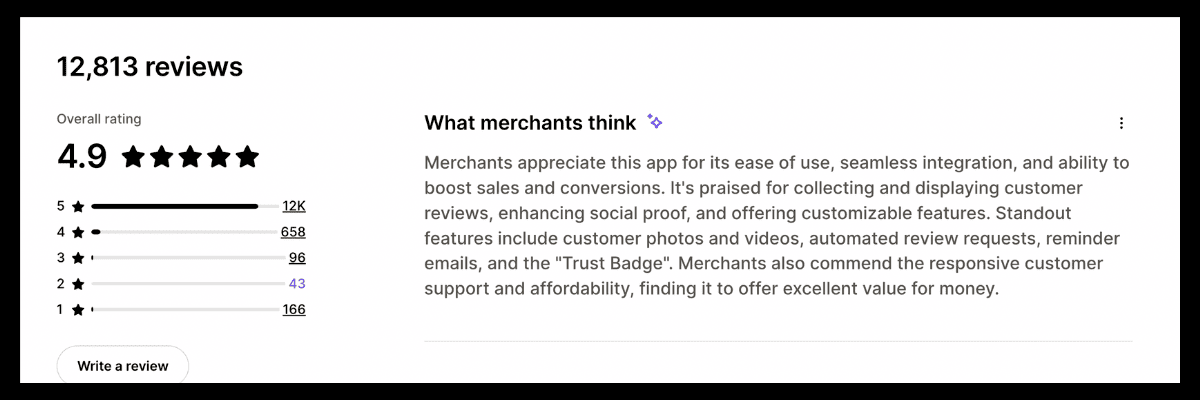
This Shopify Magic app review summary only mentions the positives.
Provide Customer Service
Shopify Inbox is a customer service chatbot that can be activated in any Shopify store. Currently, you can use it to:
- Automatically answer a customer’s FAQ
- Chat with a customer in real time
- Prompt a customer to leave their email address for a follow up
None of those basic features use AI. But Shopify is in the process of adding a bit of Magic into these customer service chats in two ways:
1. Shopify Magic can suggest what questions you should add to your FAQ, and draft the response for you. You can edit and modify these questions and answers before publishing them, and they don’t change once they’re set.
2. Shopify Magic can provide conversational chat responses to questions that are not addressed in your FAQ. This type of AI has much more freedom to answer unpredictable or subjective questions. This feature is in beta testing, and some shops have already been given early access. It’s similar to what the live chat software Tidio offers, with their Lyro AI feature.
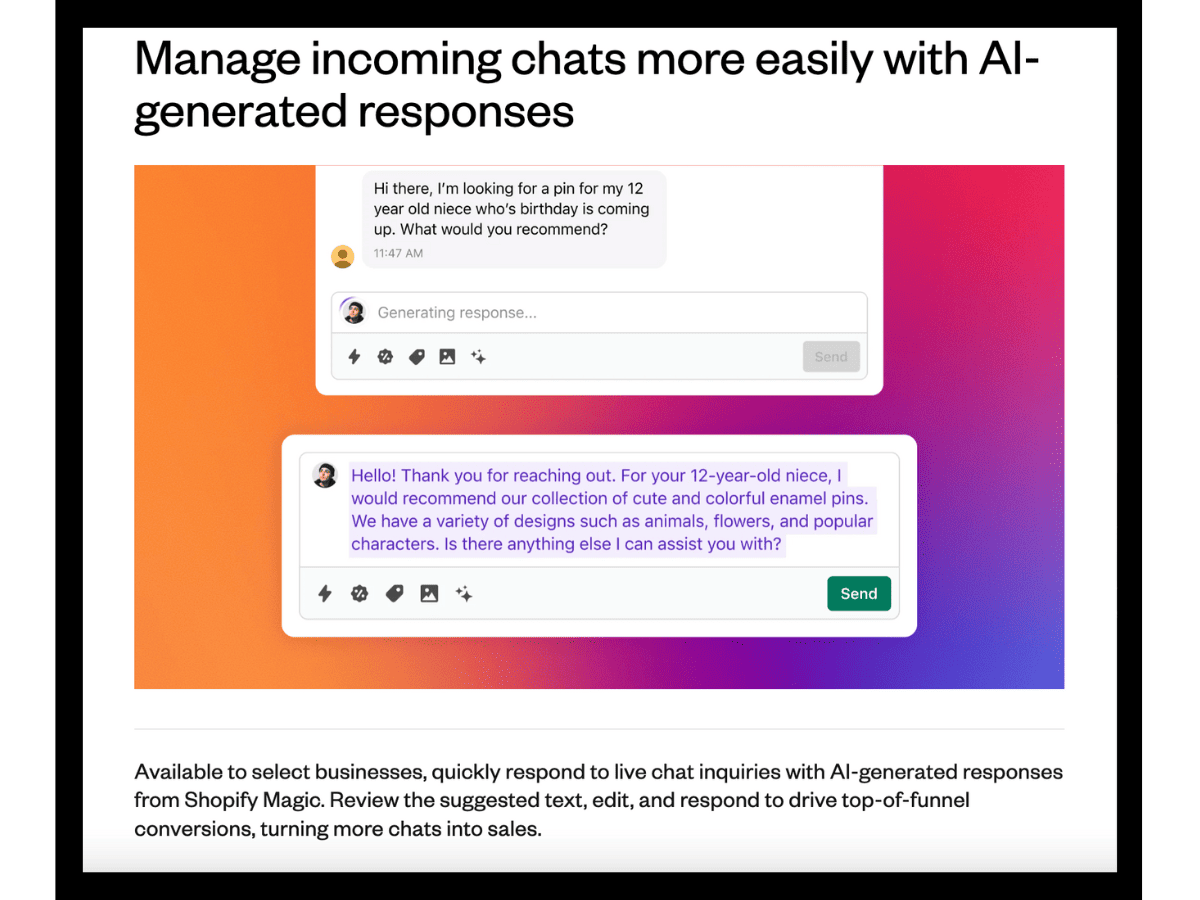
Shopify Magic can help customers get answers fast, but there are some risks to letting AI manage your customer service.
Personally, I haven’t signed up for early access to this feature because I’m nervous about an AI chatbot providing inaccurate or unhelpful answers to customer queries. I’m also not sure about the ethics of a customer chatting with an AI that they might mistake for a human. Hopefully Shopify will address these concerns in the near future.
So, we’ve touched on some of the initial advantages and challenges of Shopify Magic. But does this suite of tools really live up to the hype? Let’s take a closer look at how to effectively use Shopify Magic, as well as some common problems you might face.
Using Shopify Magic
You can use Shopify Magic to generate text wherever you see the purple star icon in your admin area. Look for it where you write product descriptions, emails, or blog posts.
Here’s how it works:
Writing Prompts
First, you’ll need to write a prompt that Shopify Magic can use to generate text. Writing good prompts is critical to take advantage of AI in your Shopify store. (And yes, 6-figure prompt engineering jobs are now a thing!) If you’re not getting the output you want from Shopify Magic, try making your prompts more detailed and specific.
Product Descriptions: the prompt should include features and keywords. For example:
- hand cream, vanilla scented, 99% natural ingredients
- unicorn horn for horse, easy to attach, straps included, magical
- avocado toast enamel pin, made in USA, stainless steel, cute
Emails: the prompt should include the email content type and important details. For example:
- welcome email for new subscribers, 10% discount
- Black Friday promotion, 25% off entire store, sale ends Monday
- abandoned cart email, limited stock, 10% discount to complete purchase
Blog Posts: the prompt should include a description of the post and relevant keywords. For example:
- an article about sustainable living practices in urban areas; keywords: urban sustainability, green living, eco-friendly
- an article about the cultural importance of unicorns across different civilizations; keywords: mythical creatures, unicorn symbolism, unicorn folklore
Choosing the Tone of Voice
When using Shopify Magic to generate text, you have to select the desired tone of voice from a drop down menu. In theory, this is to help you maintain a consistent brand voice across your website. But to be honest, I’m skeptical about how effective this feature really is.
Here are a few things I’ve noticed:
- Certain adjectives are repeated too often. For example, choosing the “sophisticated” tone frequently repeats the word “exquisite”, sometimes multiple times across a couple of sentences
- There is often very little difference between one tone and another
- When you write a custom tone, the resulting description doesn’t usually match that tone
Hopefully the “tone of voice” feature will become more polished as Shopify develops its AI technology.
Checking for Errors
Checking for errors is the most important step. You don’t want to be on the other end of those embarrassing stories of people duped by AI hallucinations!
Although I have yet to see a true AI hallucination produced by Shopify Magic, I have encountered some grammatical errors and awkward wording.
Here are a few examples to give you an idea of what to look out for.
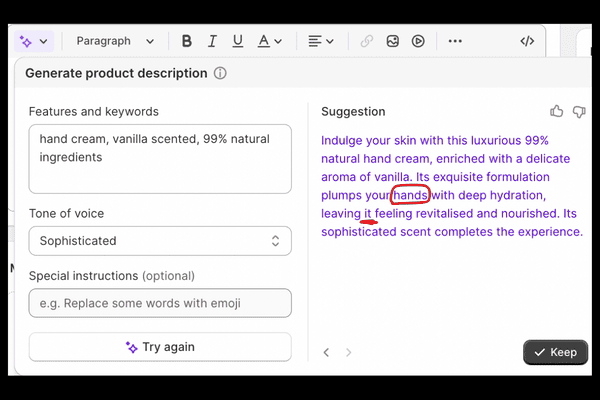
Houston, we’ve got a subject-verb agreement problem.
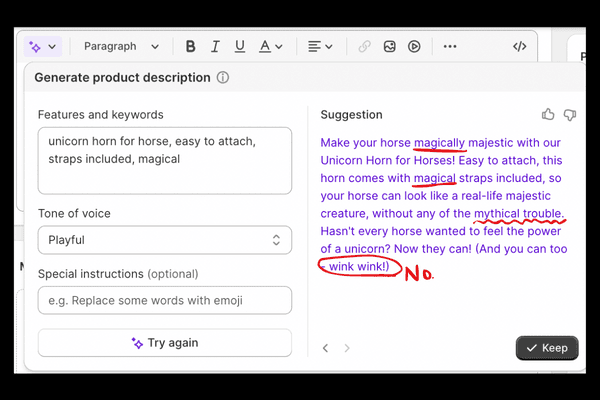
This awkward product description is simply too magical/mythical/majestic. 😬
How does Shopify Magic affect SEO?
The internet is full of misleading claims about how AI content could affect your Shopify SEO (for better or worse). To get some reliable answers, I went straight to the source.
At least for now, Google values content quality over whether it’s AI-generated or human-made. The focus should be on experience, expertise, trustworthiness, and authenticity- known in Googleland as E-E-A-T. Google doesn’t give AI-created content any ranking advantages or penalties as long as it aligns with their E-E-A-T standards.
Remember, you’re responsible for the quality and accuracy of everything you publish, whether it’s AI generated or not. Using low quality AI content just to boost search rankings won’t work. Ecommerce store owners should prioritize genuine, audience-focused content over ranking gimmicks.
Read more about SEO for Shopify here.
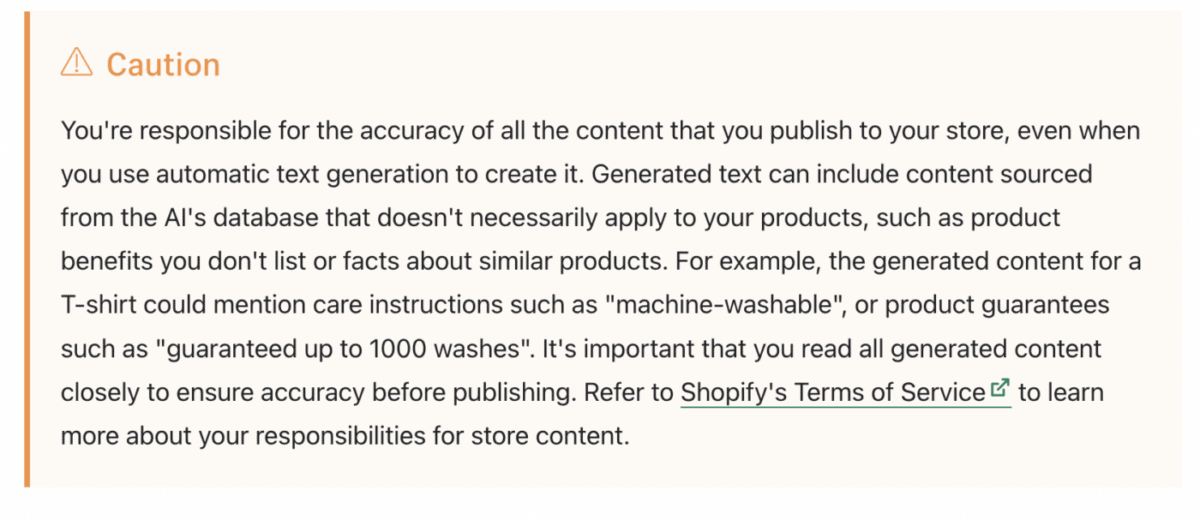
Shopify Magic can produce inaccurate content, so make sure you check it carefully before publishing.
Shopify Magic vs. ChatGPT vs. Other AI Tools
When Shopify Magic launched, I had already been exploring ChatGPT for a few months. So naturally, I had some questions:
- Is Shopify Magic the same as ChatGPT?
- If not, how do they compare?
- Are there any other AI tools I should be using in my Shopify store right now?
Here’s what I’ve learned so far.
1. Shopify Magic is not (exactly) the same as ChatGPT
Miqdad Jaffer, Shopify’s head of product for AI, explained in an interview that Shopify Magic uses both Shopify’s own data and open-source machine learning models, like ChatGPT.
So you’re often going to get similar outputs, but Shopify Magic content might be more geared towards ecommerce. Also, remember that Shopify Magic can learn from your existing website. So when it produces new content, you might recognize key words and phrases that you already use in your store.
2. Shopify Magic and ChatGPT have their own strengths and weaknesses
Because Shopify Magic and ChatGPT can give different answers to the same prompts from one minute to the next, it’s hard to say which is better overall. Sometimes I like ChatGPT more, and sometimes Shopify Magic works better. I’d suggest trying both and mixing what you like from each for the best results.
Here’s a comparison of different outputs from both Shopify Magic and ChatGPT. I’ve also added my thoughts regarding their task performance.
| Prompt | AI Product Description | The Verdict | |
|---|---|---|---|
| Shopify Magic | Features and keywords: unicorn horn for horse, easy to attach, straps included, magical
Tone of voice: Playful |
“Take your horse’s look to the next level with this magical unicorn horn! Easily attach it with the included straps, and watch your horse turn into something truly mythical. Now your regular horse can be a majestic, unforgettable creature! Ummmm… neigh!” |
|
| ChatGPT | Write a product description for a unicorn horn for horses. Use the following keywords: easy to attach, straps included, magical. Use a playful tone of voice | “Ever dreamed of transforming your trusty steed into the most magical creature of all? Now, with our unicorn horn you can do just that! Crafted for whimsical wanderers and equestrian enthusiasts alike, this horn is not only the epitome of enchantment but is also a breeze to use. With easy-to-attach mechanisms and straps included, your horse will be ready for its fairytale debut in no time. Whether you’re headed to a parade, a photoshoot, or just feeling a touch playful, let this magical accessory bring a sprinkle of fantasy to your everyday rides. Because every horse deserves a little magic!” |
|
As you can see, both Shopify Magic and ChatGPT provided decent product description suggestions. However, there were phrases in each that felt a bit awkward and wouldn’t be a good representation of my brand. But they provide a good place to start, and I can pull some ideas from each to craft my own description.
3. Beware of AI hype
There are literally hundreds of apps on Shopify offering AI capabilities, but most are unlikely to provide much functionality beyond what Shopify Magic and ChatGPT can already do.
There are a few interesting photo and video apps, but if you’re already using tools like Canva or Vimeo, you’re unlikely to be very impressed.
“AI” is currently a buzzword, but not everything that claims to be an AI tool actually is. For example, a basic product recommendation feature might just follow set rules, like showing product B after someone looks at product A. This type of software isn’t AI. It simply executes the fixed, pre-defined instructions that were programmed into it.
However, a more sophisticated recommendation system that learns and adapts over time based on vast amounts of data could be considered AI.
We recommend approaching claims of “AI” with a healthy dose of skepticism, especially when it comes to paid apps and plugins. Ask about how the AI works, what data it uses, and what kind of learning and adaptability it exhibits.
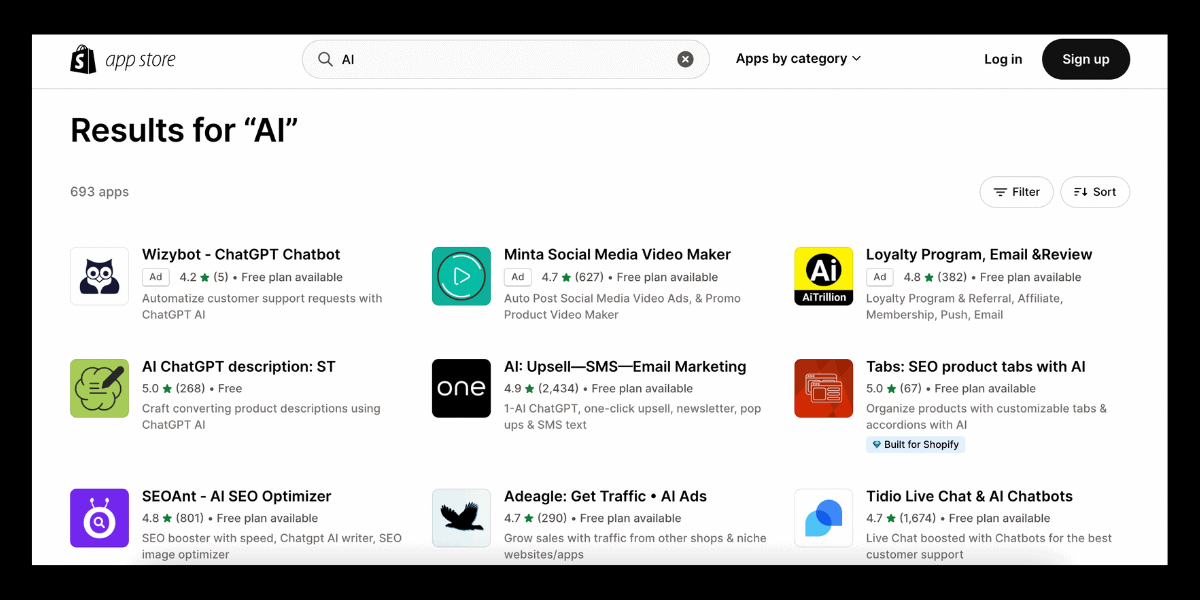
AI or A-Why?
Looking Ahead: Shopify Sidekick
Shopify has generated a lot of anticipation around its forthcoming AI feature, Sidekick. The name itself suggests a reliable assistant ready to help busy store owners in many ways. As early access rolls out, Shopify merchants are eager to see how Sidekick will perform.
So what is Sidekick, exactly? To answer that question, we need a throwback.
If you’re as old as me, you probably used Microsoft products at some point in the late 90s or early 2000s. If so, you’ll definitely remember Clippy.

Thanks to Seattle Met for reminding us how much we love/hate Clippy.
For those who don’t know, Clippy was an animated paper clip that popped up (often unexpectedly) to offer help with computer tasks. Clippy was designed to understand what a user was doing. For example, if you started creating a table in Word, Clippy might offer assistance related to tables. You could also ask it software questions, like how to set margins in a Word document, and Clippy would walk you through the process.
But Clippy was a rather annoying know-it-all, and Microsoft discontinued it in 2007. Many found its frequent pop-up suggestions intrusive, and its attempts to anticipate user needs often missed the mark.
But a lot has changed since 2007, and the idea of an intelligent digital assistant now doesn’t seem so far-fetched.
Enter Sidekick.

Cuter than Clippy? We’ll let you decide
To be honest, Shopify’s early previews of Sidekick have me very excited. I’ve been running my Shopify store for years, but I still find myself spending tons of time clicking around to do basic admin, like programming sales or changing prices. Sidekick could change all of that.
The idea is that Sidekick will:
- Know everything there is to know about Shopify and be able to answer any questions you have
- Be deeply competent about your business and entrepreneurship in general
- Will be able to execute tasks in your store if you ask it to
- Will be able to answer questions about your business and offer suggestions based on your shop’s data and wider economic trends
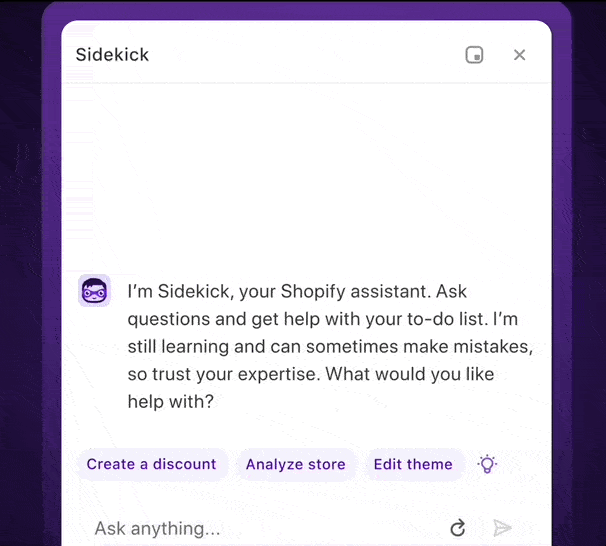
Using natural language to have Sidekick quickly execute tasks in Shopify? SIGN ME UP.
If Shopify delivers, I think Sidekick will become an absolute game-changer in ecommerce.
I’ll report back as soon as Sidekick becomes available. (Shopify staff- if you’re reading this, please give me early access!)
AI, AI Everywhere
Shopify is certainly not the only ecommerce platform jumping on the AI bandwagon. In fact, AI-generated product descriptions, emails, and blog posts are quickly becoming a standard feature across the industry.
Here are a few notable tools that other top ecommerce platforms have going on in the AI department.
Wix ADI (Artificial Design Intelligence)
Wix ADI can essentially create a website for you based on answers to a few questions about your business. This allows users with minimal design experience to craft whole websites using AI.
However, Wix ADI has some challenges. While Wix ADI does allow customization, the starting templates can feel repetitive. This leads to websites that have a recognizable Wix ADI feel to them.
We view Wix ADI as an excellent tool for basic websites, or as the groundwork for more complex ones. But creating a unique website often requires further customization and content creation beyond the initial Wix ADI setup.

Don’t do this! You’ve still got work to do if you use Wix ADI to build a website.
Read our full Wix review here.
Squarespace Blueprint
Like Wix ADI, Squarespace’s Blueprint assists in building a website by modifying the layout and style of its templates based on a few user inputs. Blueprint is more of a guided design system rather than pure AI, but it does use some machine learning and AI principles.
Like the name suggests, Blueprint is a starting point to begin building a website, rather than a final product.
Interested in Squarespace? Here’s our review.
WooCommerce
WooCommerce is an ecommerce plugin for WordPress, so it doesn’t have built-in AI tools in the same way that Shopify, Wix or Squarespace do.
However there are a few ways to use AI in a WooCommerce store.
WooCommerce recently announced an experimental AI-assisted product listings feature for new Woo Express users. It isn’t available to everyone yet, but it’s set to be more widely accessible in the near future.
To be honest, this feature’s limited availability and restriction to only product listings put it miles behind Shopify Magic.
You can also install third-party solutions with AI capabilities, but remember to proceed with caution!
We’ve got lots more to say about WooCommerce here.
Shopify AI: Final Thoughts
Artificial Intelligence tools like Shopify Magic have taken the ecommerce world by storm. Some people are understandably nervous. They fear job replacements or the rapid spread of misinformation. While these fears are valid, other people (like me) are cautiously optimistic.
In my own shop, I view AI as a collaborator. I mostly use Shopify Magic and ChatGPT as sounding boards to bounce around ideas. (Email subject line suggestions are a personal favorite!) I’m excited about AI’s ability to automate marketing tasks and analyze vast amounts of data. But when it comes to the creative side of running a business, I believe humans can still do a better job.
No matter what your feelings about this technology are, AI literacy will be critical in the near future. Those who understand and effectively use Shopify Magic (and similar tools) will likely lead the next wave of ecommerce innovation.
Fortunately, Shopify is on board with rapidly advancing developments in AI. And tools like Shopify Magic demonstrate their commitment to staying ahead of the curve. We’re looking forward to seeing what AI tools Shopify comes up with next.
> Learn more about Shopify in our review
Have you tried Shopify Magic in your store? Are there any other AI tools you love? Let us know in the comments below!
We keep our content up to date
25 Apr 2024 - Added Tiktok video
THE BEHIND THE SCENES OF THIS BLOG
This article has been written and researched following a precise methodology.
Our methodology